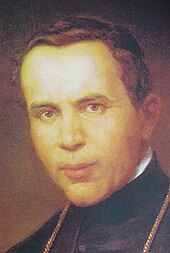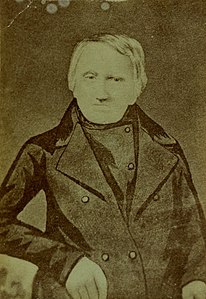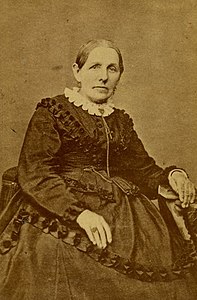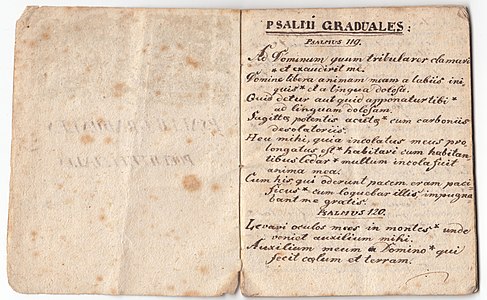Johann Nepomuk Neumann
Johann Nepomuk Neumann CSsR (Czech Jan Nepomuk Neumann or Jan Nepomucký Neumann ; born March 28, 1811 in Prachatitz ; † January 5, 1860 in Philadelphia ( Pennsylvania , USA )) was a Catholic priest, Redemptorist , fourth bishop of Philadelphia (1852–1860 ) and has been a saint of the Roman Catholic Church since 1977 . He is the first American bishop to be canonized. As Bishop of Philadelphia, he established the first Catholic parish school system in the United States.
Life
Family background
Johann Nepomuk Neumann was the son of the stocking weaver Johann Philipp Neumann (born October 16, 1774) and Agnes Lebisch from Prachatitz, who immigrated from Obernburg am Main ( Lower Franconia ) in 1802 .
His father, Philipp Neumann, moved to Bohemia around 1799 because of the Napoleonic campaigns, as otherwise the forced recruitment of young men by the French army, which was common at the time, threatened. A deposit of the significant sum of 2000 guilders in March 1800 in the Magistrate of Netolitz is documented. On April 22, 1802, Philipp Neumann asked the local magistrate of Prachatitz to be accepted as a citizen and master stocking maker, an application that was granted at the magistrate's meeting two days later. Philipp Neumann then married Antonia Strachotinsky. The marriage remained childless and the first woman died on November 26, 1804 of puerperal fever. He acquired the parent company on Obere Strasse in 1806 through a highest bid at the auction of the house of a recently deceased master tailor. In his second marriage he married Agnes Lebisch on June 17, 1805. The daughter of a master saddler was deeply religious and attended holy mass every day. As a hosiery master he trained apprentices and journeymen and he was a member of the imperial guild, which he served as one of the guild masters from 1820 to 1841. In 1813 he was one of the three Prachatitz city keepers. From 1819 onwards, the couple was active in the Prachatitz Book Club, a bibliophilia that was carried over to their descendants.
Johann Nepomuk was baptized in the town church of St. Jakob . The chapel in which the baptismal font is located has been named after him since 1993. He had six siblings, Katharina (April 8, 1806 - June 14, 1889), Philipp (February 1, 1808 - May 6, 1808), Veronika (February 3, 1809 - June 25, 1850), Johanna (April 19, 1813 - April 22, 1887), Aloisia (May 13, 1815 - July 27, 1886) and Wenzel (September 4, 1817 - April 10, 1896). The younger brother Wenzel apprenticed to his father as a stocking maker, emigrated to North America in 1839, also joined the Redemptorists, worked as a cook, among other things, and died in New Orleans.
education
Johann Nepomuk Neumann started school on November 1, 1817 in the Prachatitz City School. In the first grade, the teacher entrusted him with the guidance of his classmates. Outside of school he learned the basics of the Latin language from the catechist from 1822 to 1823.
From 1824 he went to the Piarist high school in Budweis , where he completed a two-year philosophical study from 1829-1831.
From the fall of 1831 he wanted to study medicine in Prague , a project that met with the approval of his father, but the fundamental rejection of his deeply religious mother. She really wanted him to pursue a spiritual career. Because the mother was able to prevail, the son entered the seminary in Budweis on November 1, 1831 .
In the autumn of 1833 he began his theology studies in the Archbishop's Seminary in Prague, specializing in philosophy, theology, mathematics, natural sciences and Latin. He passed the final exams on July 6, 1835. Since there was a surplus of priests in the diocese of Budweis at that time , the ordination was postponed for months for the entire year of ordination .
Emigrant and missionary
The decision to go to North America as a missionary after completing his priestly studies was made in the seminary in Budweis. One reason for this was the statements made by the Slovenian missionary and later Bishop Friedrich Baraga in the 'Nachrichten des Leopoldsverein' of the Leopoldinenstiftung in Vienna, which were displayed there. Due to the wave of immigration to the United States at the time, there was an immense need for German-speaking priests. The moment of the decision can even be dated to the spring of 1833, when the rector of the seminary, Johann Kröner, read from the eleventh chapter of the second letter to the Corinthians, in which Paul describes his suffering for the gospel.
He acquired and deepened his English language skills in discussions with English workers at the Prague factory. He even won a tender for English interpreters in the diplomatic service, but did not take the position. He also attended French lectures in the Klementinum .
After receiving the episcopal blessing in Budweis in February 1836, he traveled 70 days via Linz, Munich, Stuttgart, Ulm and Strasbourg to Paris . The rector of the Strasbourg seminary promised a recommendation to the Bishop of New York and gave him a box of books. He celebrated his 25th birthday in Paris, which was then considered the center of vice and sins. There he missed the departure of the rental car to Le Havre. The coachman hired to replace him abandoned him on the outskirts of Paris. So Neumann walked with his two suitcases and the box of books to Saint Germain, where he reached the port in Le Havre with another car. There he embarked on April 20, 1836 for the forty-day voyage with the three-master Europe.
On June 1, 1836, he arrived in New York and was ordained a priest from Bishop John Dubois just four weeks later, on June 25, 1836 . Concern for the German congregation and the question of the school system is a main topic even at the beginning of the missionary work, as a letter of June 27, 1836 shows:
- The plight of the Germans here is greater than one can imagine. They seldom brought religion with them from Europe, as a great lust for freedom and greed for money are common causes of their emigration. The religious instruction of the youth, of which I had the opportunity to convince myself, is almost completely ruined. Most of the children are sent to English schools by their parents, because Germans, especially those who have been here for a long time, are ashamed of their language, and knowing English is really very beneficial. (...) Most of the good things can be achieved in school. Because as soon as the parents notice that one likes to spend time with their children and that they do not make any big demands on their cash register, their religious sense awakens again, since the great obstacle of poverty disappears, and the children come more often and more often.
First he was sent to Williamsville (north of Buffalo ), where he completed the construction of the church and founded his first Catholic school. The parish area had a circumference of 1450 square kilometers, which he constantly wandered through with a backpack.
When he collapsed exhausted on Easter 1840, he was taken to a Redemptorist convent to relax. On November 30, 1840 Neumann joined the Redemptorist Order . After he had made his profession on January 16, 1842 in Baltimore , Maryland , he became pastor of St. Alfonso there. The community, in whose area mostly German emigrants lived, had ten outstations. Provincial councilor since 1843 , he became head of the Pittsburgh monastery in 1844 and finally in 1846 as vice provincial the head of all American branches of the order. He published two catechisms and a biblical story.
In the fall of 1846 he had a serious respiratory illness (uninterrupted strong coughing, sometimes with blood), which he probably contracted from the air pollution during his long stay in the industrial metropolis of Pittsburgh.
Bishop of Philadelphia
With a bull dated February 1, 1852 Neumann was from Pope Pius IX. Appointed Bishop of Philadelphia in recognition of his excellence in pastoral care and intellectual abilities. He received his episcopal ordination on March 28 of the same year by his predecessor and new Archbishop of Baltimore , Francis Patrick Kenrick . Co- consecrator was the Bishop of Hartford , Bernard O'Reilly and Bishop Dubois. He was the youngest bishop in the United States to date. As bishop he chose the motto: Passio Christi conforta me (“Passion of Christ, strengthen me!”) From the prayer Anima Christi .
In his tenure, which lasted only eight years, he began building the Philadelphia Cathedral and established a seminary. He founded over 100 churches and almost as many schools in his diocese. At the time of inauguration, Philadelphia had 400,000 residents, a quarter of whom were Catholics. Within the first year of office, the number of children in Catholic schools had risen from 500 to 5000. Thereby he laid the foundation stone for the church parish school system in today's USA.
As a bishop, Neumann primarily cared for the common and poor. He knew from personal experience that a good school education is the decisive key to improving the socially disadvantaged classes.
With the appointment as bishop, the chances of a home visit increased, because at that time the American bishops had the duty to pay an ad limina visit to the Pope every ten years . This visit took concrete shape surprisingly when Pope Pius IX. in October 1854 called all bishops to Rome; on December 8, 1854, Pope Pius IX. In St. Peter's Basilica in front of 55 cardinals, 150 bishops and 50,000 priests, friars and believers, the dogma Ineffabilis Deus of the Immaculate Conception of the Blessed Virgin Mary became known. On December 16, Johann Nepomuk Neumann had a private audience with Pope Pius IX, with which the official part of the stay in Rome ended. On the onward journey he stopped among the Redemptorists in Leoben and Vienna . In Prague he was received for lunch by the abdicated Emperor Ferdinand in 1848 , who donated a larger amount for the construction of the cathedral in Baltimore. In the sleigh of Budweiser Bishop Jan Valerián Jirsík , he finally drove via Netolitz to his hometown in the Bohemian Forest, whose inhabitants gave him an overwhelming welcome.
The 9th Regional Council in Baltimore in 1858 took an undecided position in the then heated debate about slavery in the USA , but decided to establish a school for African-American children.
The typical daily routine of the bishop in his last years was as follows: getting up at 5 a.m., prayer in the house chapel, 6 a.m. holy mass with seminarians, from 7 a.m. acceptance of confession, up to several hours; for lunch there was a cup of coffee and a piece of bread; In the afternoon there were visits, audiences, official acts, sometimes until midnight in the evening, the night's sleep has been shortened to two or three hours in recent years.
On January 5, 1860 at 3 p.m., the only 1.60 meter tall man collapsed on the street due to a cardiac arrest and died on the same day. He was buried in the Redemptorist Church in Philadelphia. The beatification process began in 1886 and ended on October 13, 1963 with the beatification. On June 19, 1977 Johann Nepomuk Neumann was appointed by Pope Paul VI. canonized.
Remembrance day
- Catholic: January 5th
- Obligatory Memorial Day on the US regional calendar
- Since 2004 a memorial day not required in the regional calendar for the German-speaking area
- In addition, a memorial day not required in the list of celebrations of several German (arch) dioceses, including all Bavarian dioceses, the Archdiocese of Freiburg , the Diocese of Fulda , the Diocese of Hildesheim , the Diocese of Mainz , the Diocese of Limburg and the Diocese of Rottenburg-Stuttgart . The Directory for the latter diocese stated that January 5th was included in the calendar of the Rottenburg-Stuttgart diocese as a day of remembrance for Neumann in view of his (Bohemian) compatriots, who have found a second home after the expulsion in Württemberg.
Appreciation
- In Neumann's birthplace, the Neumanneum , a chapel was inaugurated on July 25, 1992, which bears his name. After the renovation work, the chapel was rededicated on June 10, 2017. On the 40th anniversary of Neumann's canonization, the Congregation of the Sisters of Mercy in cooperation with the city and the Roman Catholic parishes of Prachatice also opened a gallery in the Neumanneum.
- In front of the Hospic sv. Jana N. Neumanna at Neumannova 144 is a bronze statue of the saint.
- The baptistery of the town church of St. Jacob in Prachatice was consecrated on October 11, 1993 in honor of the saint. There is also a statue of the saint in the church.
- In Obernburg am Main the lower church is consecrated to the name of the saint. Two glass windows show the life of Bishop Johann Nepomuk Neumann.
- The Bischof Neumann School in Königstein im Taunus is named after the bishop.
- In the US cities of Cincinnati and Sunbury (Ohio) as well as in Knoxville (Tennessee) , Johann Nepomuk Neumann is the patron saint of the respective Saint John Neumann Church .
- There is a shrine of the saint in St. Peter's Church in Philadelphia.
- USA President Barack Obama presented Pope Benedict XVI as a gift during his visit to the Vatican in July 2009 . a stole of the holy bishop Neumann. Benedikt returned the favor with a special book edition of his social encyclical Caritas in veritate .
gallery
- The relatives of Johann Nep. Neumann
- Jan Nepomuk Neumann in documents
literature
- Constantin von Wurzbach : Neumann, Johann Nepomuk . In: Biographisches Lexikon des Kaiserthums Oesterreich . 20th part. Kaiserlich-Königliche Hof- und Staatsdruckerei, Vienna 1869, pp. 267–269 ( digitized version ).
- Pavel Liška: St. John Nepomucene Neumann. Saint Johannes Nepomuk Neumann. Prachatice 2011, ISBN 9788071954590 (English pp. 8–124, German pp. 125–235).
- Karl Reiss, Josef Lieball (Ed.): Johannes Nepomuk Neumann. Bishop in Philadelphia. The saint from the Bohemian Forest (= series of publications by the Sudeten German priestly work. Volume XXIII). Königstein im Taunus 1979.
- Augustin Reimann: son of the Bohemian Forest and Bishop of Philadelphia - Johann Nepomuk Neumann . Sudetendeutsches Priesterwerk, Königstein / Taunus 1960, 103 pages.
- Václav Stary: Saint Johann Neumann and Prachatitz . City Office Prachatitz, 75 pages.
Web links
- Entry on Johann Nepomuk Neumann on catholic-hierarchy.org
- Johannes Nepomuk Neumann in the Ecumenical Lexicon of Saints .
- Johann Nepomuk Neumann. In: kohoutikriz.org (richly illustrated website on Johann Nepomuk Neumann; Czech).
- Johann Nepomuk Neumann: Apostle of the New World - The church historian Rudolf Grulich on the American saint from the Bohemian Forest.
- Martina Schneibergová: From Prachatice to the Niagara Falls: St. Johann Nepomuk Neumann. In: Radio Prague International, June 30, 2011 (German), accessed October 17, 2019.
- The beatification of Bishop Johann Nepomuk Neumann in 1963 - historical audio report about a pilgrimage to the beatification on October 13, 1963
Individual evidence
- ↑ a b c Rodný dům sv. Jana Nepomuka Neumanna (German birth house of Saint Johann Nepomuk Neumann ). In: neumanneum.cz (Czech).
- ^ Morris J. McGregor: The Emergence of a Black Catholic Community. St Augustine's in Washington. The Catholic University of America Press, Washington 1999, p. 26.
- ↑ https://www.drs.de/fileadmin/drs/documents/arbeitsfelder/liturgie/2018_liturgischer_kalender.pdf p. 173, accessed on June 10, 2019.
- ↑ Lenka Houšková: Nova gallery poctě k sv. Jana N. Neumanna v Prachaticích. In: prachatice.eu (Czech with automatic translation option), February 23, 2017, accessed on October 17, 2019.
- ^ Bishop Neumann School. Königstein im Taunus. In: bns.info, accessed on October 17, 2019.
- ↑ http://sjnews.org/
- ↑ http://www.saintjohnsunbury.org/
- ↑ https://sjnknox.org/
| personal data | |
|---|---|
| SURNAME | Neumann, Johann Nepomuk |
| ALTERNATIVE NAMES | Neumann, Johannes Nepomuk |
| BRIEF DESCRIPTION | Bishop of Philadelphia and Saint of the Catholic Church |
| DATE OF BIRTH | March 28, 1811 |
| PLACE OF BIRTH | Prachatitz |
| DATE OF DEATH | January 5, 1860 |
| Place of death | Philadelphia |










